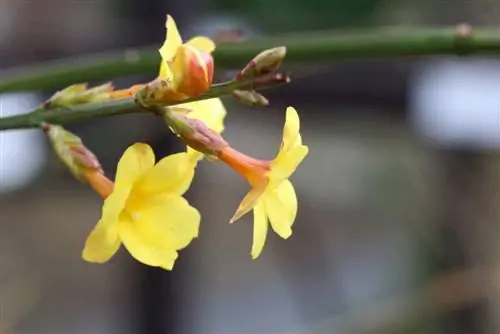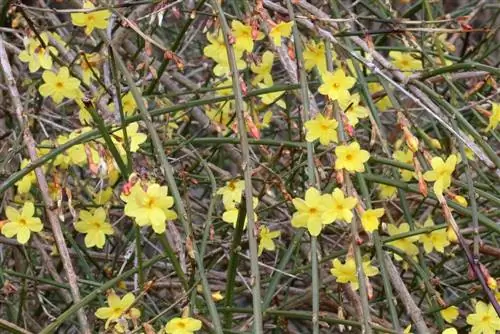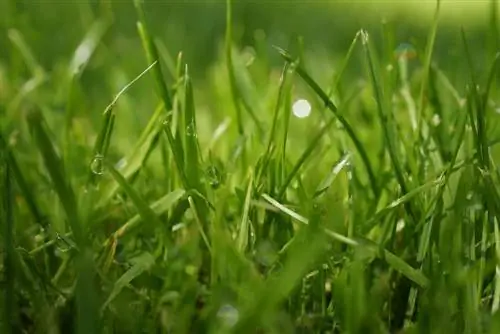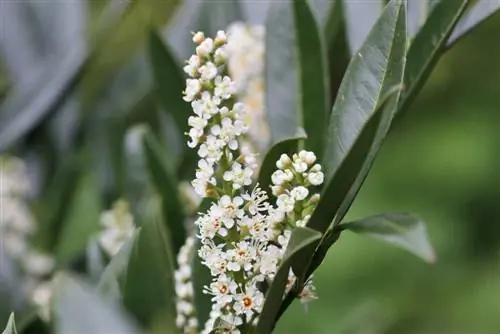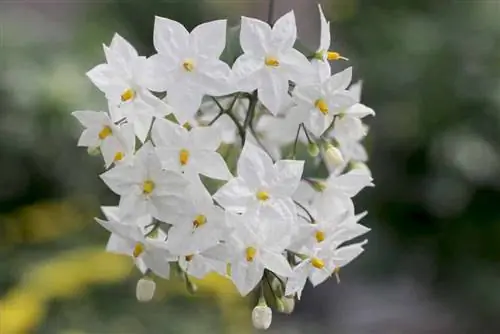- Author admin [email protected].
- Public 2023-12-17 03:39.
- Last modified 2025-01-24 12:45.
Winter jasmine has the botanical name Jasminum nudiflorum and belongs to the olive family. Because it blooms without leaves, it is nicknamed 'nudiflorum', which is used in botany to describe naked-flowering plants. Already in the winter months, the undemanding plant delights the garden owner with bright yellow flowers and has a high ornamental value. Due to the strong growth, regular pruning is necessary.
Location & plant substrate
The winter jasmine depends on a suitable location in order to be able to grow and thrive there. In its native China it grows on rocky slopes in high mountain areas and is therefore very weatherproof. The plant tolerates strong heat and direct sunlight as well as cold temperatures. Even the air in large cities, which is often very dry and polluted with fine dust, does not affect the robust plant. Jasminum nudiflorum also has little demands on the plant substrate and grows on poorer and sandy soils. Over time, winter jasmine can spread into a voluminous shrub. If it is allowed to grow without interference, extremely dense and tangled growth forms will form. As soon as the long and curved branches come into contact with the ground, they quickly root there.
- Cultivation possible directly outdoors and in pots
- Sunny to slightly shady location is ideal
- The flowers are less abundant in shady places
- Growth can be controlled with climbing aid
- Looks good in front of house walls, walls and on trellises
- Suitable as an undemanding plant for spaces in hedges
- I'm happy about the space in the unheated winter garden
- Very easy to grow, needs sufficient space
- Plant protected from extreme cold and too much wind
- Prefers calcareous and nutrient-rich plant substrate
- Humus-rich, loose and permeable soils are good
- Soil with alkaline to slightly acidic pH values is optimal
Tip:
Jasminum nudiflorum does not cope well with deep soil qualities and heavy clay soils. In winter, the plant can suffer from frost in these conditions, so such soils should be loosened before planting.
Sowing
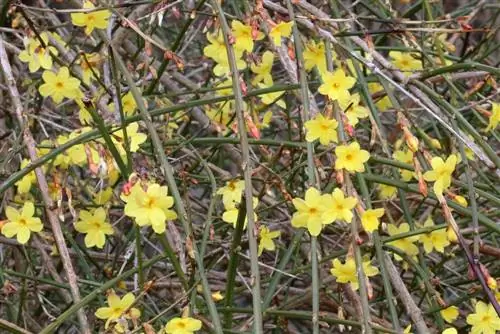
In conventional garden centers, Jasminum nudiflorum is mainly available as a container plant in different sizes. Only specialized dealers carry seeds of this plant. If you want to sow the plant, you can collect the seeds from your own specimens. Alternatively, the seeds you need can also be obtained from family and friends. Only when the young plants are strong enough should they be exposed.
- Collect and use only ripe seeds
- Sprinkle seeds into pots with growing soil
- Press lightly and cover with soil
- Then keep evenly moist
- Cover with clear plastic wrap
- Air every now and then to avoid mold
- Don't plant until the following spring
Plants & Plant Neighbors
Winter jasmine should be planted either early in the year or at the end of the growing season. The plant then has enough time until winter to grow well and develop a strong root ball. Due to its rapid and rampant growth, the plant is ideal for strengthening soil on slopes. Jasminum nudiflorum also thickens poor embankments and adds greenery to garden fences and walls. The garden shrub brings variety to flower gardens, courtyards and alpine rock gardens. If the plant is to grow taller, it needs support in the form of a trellis, a tree trunk or another high background. Due to the early flowering, it is advisable to plant close to early-flowering trees, bulbous and bulbous flowers.
- Plant either in spring or autumn
- Can be cultivated as a ground cover or climbing plant
- Do not place individual plants too close together
- Maintain a distance of approximately half the width of the expected growth
- For hedges and fences, keep a distance of approx. 1 m
- Suitable between hedges, e.g. E.g. hornbeam, privet and thuja
- Suitable for crocuses, snowdrops and star magnolias
- Dig a sufficiently large planting hole
- Fill with a little organic fertilizer
Note:
If you want to prevent the shrub from spreading uncontrollably, you should make sure that no overhanging shoots and branches touch the ground.
Watering & Fertilizing
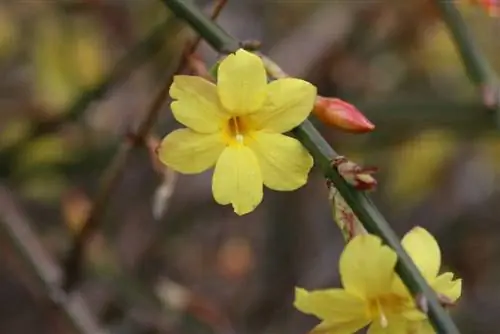
Winter jasmine is a relatively resilient plant that usually grows and thrives on its own. Therefore, it does not require intensive care when watering or fertilizing. Especially if the soil is very nutrient-rich, additional fertilizers are not really necessary. If Jasminum nudiflorum is in a location with moist soil and lots of rainfall, then no further watering is necessary. However, the plant does not like long-term drought and reacts very sensitively to it.
- Water regularly but moderately
- Water especially on hot summer days
- Waterlogging is not tolerated well
- Fertilize in nutrient-poor soils
- Organic fertilizers are ideal
- This includes rotted manure and well-ripened compost
- Give a little lime in the spring
Leaves, flowering time & growth
Winter jasmine is a climbing plant, but it does not develop any additional climbing shoots or separate climbing organs. Instead, the spreading climber climbs up its trellis with the help of long, thin shoots. After planting, the Jasminum nudiflorum only grows a little in the following years, but then it shoots up in height and width quite quickly. If the plant has to do without a supporting device, an upright crown will not form. Rather, the thin shoots spread flat over the ground. If the plant grows along a wall, over time it will form a decorative overhang. This overhang can grow well beyond the top of the wall and form a dense mat of green and flowering matter. The flowering time depends heavily on the location and the prevailing temperature values.
- Forms extremely long, thin and square shoots
- Shoots initially grow green and turn brown with age
- Can reach heights and widths of 2-3 m
- Adopts an overhanging growth habit over the years
- Forms single flowers in bright yellow color
- Flowering time varies, generally from January to April
- Blooms in mild weather from December
- Flowers open gradually, have no scent
- Afterwards small berries appear
- Light green leaf color, leaves only come after flowering
- Threefold and oval leaf shape
- Foliage is summer green, is completely shed in winter
Cutting
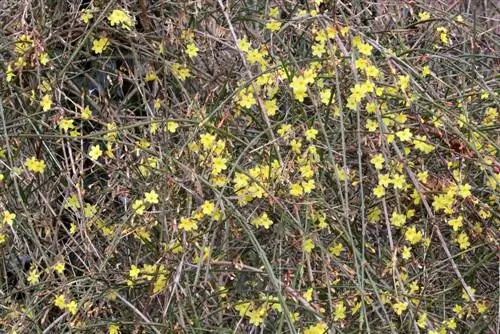
If the site conditions are right, widespread spread often occurs. Therefore, if space is limited, the plant should be checked and trimmed regularly. Especially when growing as a ground cover, the constant urge to spread must be restricted accordingly. The winter jasmine then grows back very quickly and appears rejuvenated. If there is enough space, regular cutting is not necessary as the plant ages very slowly. However, the Jasminum nudiflorum should only be pruned after flowering, otherwise the plant will be weakened too much. New flower shoots will then form until winter.
- Extremely cut-tolerant plant
- Only cut the plant from April and only until autumn
- Short branches except for a few eyes
- For older bushes, radical pruning is recommended
- Cut into the old wood
- Flowering shoots can be used as flower decorations
Wintering
Although winter jasmine is relatively insensitive to cold due to its origin, the early flowers can be damaged in the cold winter months by unexpected and very severe frost. If the plant was exposed in spring, it has time throughout the growing season to acclimatize and root sufficiently. Afterwards, overwintering is usually not a problem. Nevertheless, it is useful to protect newly planted specimens in the garden from excessively cold temperatures before the first winter season. Alternatively, young plants can spend their first winter in the greenhouse or in the unheated winter garden, then they will survive the cold season without any problems. With potted plants, there is always a risk that the roots will freeze in particularly cold winters. That's why the roots in particular need good protection from too much cold.
- Winter-hardy plant, also thrives in alpine mountain locations
- Flowers are not frost hardy, need winter protection
- Protect from cold winds with fir branches
- On the other hand, buds can tolerate temperatures down to -15° Celsius
- A place in the garden protected from the wind is ideal as winter quarters
- Take winter protection measures for potted plants in autumn
- Wrap the plant pot with thick fleece, an old sack or wool blanket
- Insulate the floor with a warming mat
Propagate
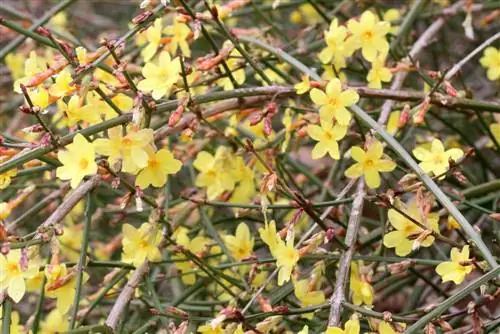
If the winter jasmine feels completely comfortable in its location, then it will multiply abundantly on its own and form numerous burrows. Seeds are rather rare for the plant, which is why offshoots and cuttings are increasingly suitable for the desired propagation. In most cases, this process is quite unproblematic. When pre-growing indoors, you should wait until the new plant is sufficiently rooted and looks strong enough before transplanting.
- Soil shoots often form roots on their own
- Sear these areas in spring with a sharp spade
- Then continue cultivating elsewhere
- Propagate from cuttings in early summer
- Cut shoots about 20 cm long from the side shoots
- Only use woody and unrooted shoots
- Prefer shoots in the cultivation container
- Keep warm and moist under a transparent plastic hood
- It is essential to keep it from drying out
- Then plant in the garden or in a pot
Tip:
If you lightly scratch the countersinks on the underside, it will make it easier for the plant to form new roots.
Diseases & Pests
Due to its robust properties, winter jasmine is rarely attacked by diseases and pests. However, powdery mildew and aphids can occasionally occur, but in most cases the climbing shrub is not significantly damaged.
- Lowly susceptible to aphids
- Shower with a strong jet of water
- Then wash off with soapy water
- Cut off plant parts affected by powdery mildew early
- Treat with environmentally friendly antidotes in severe infestations
- Preparations based on copper and sulfur are ideal
- Strengthen the plants' defenses as a preventive measure
- Broth made from field horsetail is suitable for this

